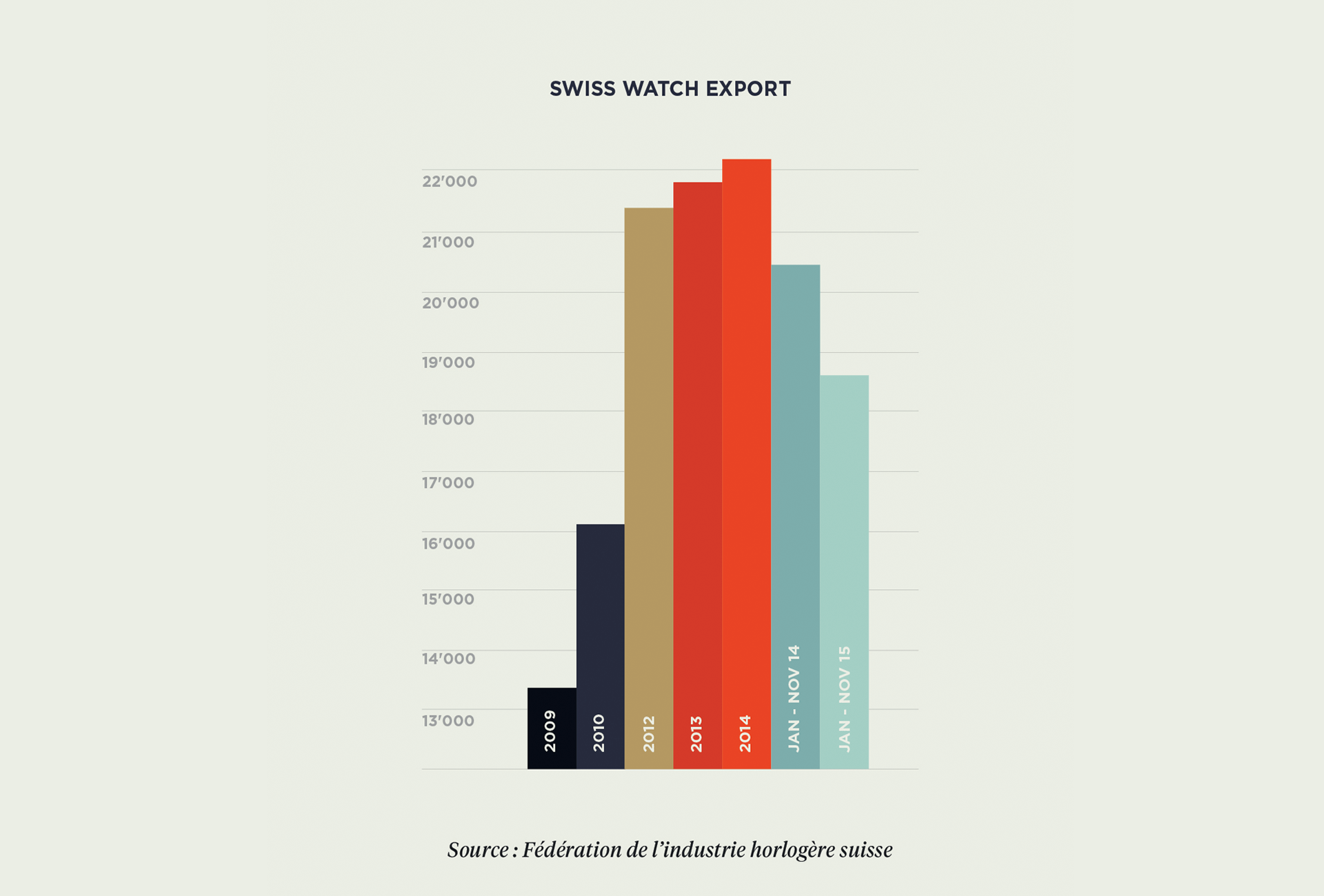Barely have the twelve strokes of midnight died away, when the watchmaking community starts gearing up for the Salon International de la Haute Horlogerie, held each January in Geneva. But as 2016 gets underway, wishes for health, wealth and happiness are tinted by a somewhat darker sentiment. Over the first eleven months of 2015, exports of Swiss wristwatches fell by 3.8%. On this basis, and given the continued decline seen throughout the quarters, observers suggest that for 2015 as a whole, shipments will be down by between 4% and 5%. This will be the first time the industry has witnessed a reversal of fortune since 2009 when, in the wake of the global subprime crisis, Swiss watch exports crashed by 22.3%.
"The other bad news"
The situation today is nothing like as drastic, although watchmakers are still justified in showing caution as four of their five main markets take a nosedive (see table). It’s virtually a year to the day since the Swiss National Bank scrapped the euro ceiling against the franc, a means of boosting trade with the European Union, and in doing so pulled the rug from under watch industry growth. This proved an underhand blow to the country’s export industries, whose margins inevitably took a tumble in the face of the stronger national currency. More storms were brewing however, with the capacity to cause potentially greater damage. As Karl-Friedrich Scheufele, co-president of Chopard, recently observed in Swiss daily Le Temps, “the other bad news is, of course, Hong Kong. Even though it will remain a major hub for watches, Beijing and Shanghai will take on more importance. Hong Kong is set to lose the supremacy it attained over the past decade.”
Once again, the figures speak for themselves. Between January and November 2015, exports of watches with an ex-works price above CHF 1,500 (multiply by ± 3 for the retail price) plunged by 25% to Hong Kong and by 10% to mainland China. Already last spring, a federation of retailers in this special administrative region hit the panic button. In a joint letter to Swiss watchmakers, they pointed to a “profound crisis” as sales plummeted by some 40% in the first quarter of 2015 and inventory reached “an incalculably high level of 6 to 10 months for certain brands.” Driving the point home, they demanded that Swiss watchmakers sort out their pricing policy and allow discounts. The situation has barely improved since then and for good reason: the Chinese economy has hit a bump in the road, and each jolt sends waves that are felt as far away as the Alpine nation. Put simply, if Swiss watchmaking has been flying high these past years, it’s in large part thanks to the Chinese dragon, so when the mighty roar turns to a wheeze, the entire sector stops to catch its breath.
Unstable equilibrium
The consequences aren’t the kind businesses like to dwell on, with a raft of redundancy announcements in recent months, not only from the big names in watchmaking but also the contractors who supply them and who, given the trend for vertical integration, are generally first to suffer when orders dry up. Massive destocking can also be expected over the coming months, which will do nothing to brighten prospects. China’s accelerated devaluation of the yuan in early January is another nail in the coffin that prompted a fall in the Shanghai and Shenzhen stock markets. The Chinese authorities have no choice than to adjust to slacker growth. Meanwhile, the United States has embarked on a tight monetary policy that will restrict the flow of money into the economy, which until now had been used to ward off a second Great Depression.
While it's no longer high days and holidays for the Swiss watch industry, nor is it all doom and gloom.
While it’s no longer high days and holidays for the Swiss watch industry, nor is it all doom and gloom. “While there can be no denying the drop [in exports] to Hong Kong, we need to interpret these figures for what they are, namely that the same Chinese customers are transferring their purchases to other parts of the world,” says Juan-Carlos Torres, CEO Vacheron Constantin. Nicolas Bos, at the head of Van Cleef & Arpels, notes that “Asia and Hong Kong remain fabulous markets for watches and jewellery. After China opened, we witnessed years of extraordinary growth. Now we have entered a period of maturity, stability and ultimately more moderate growth.” Whereas Chopard has seen its watch sales stagnate in 2015, Karl-Friedrich Scheufele points out that “jewellery sales are progressing. This is a growing market and Chopard isn’t the only one to benefit.” The Federation of the Swiss Watch Industry and its president Jean-Daniel Pasche are therefore maintaining a forecast of “relative stability” for exports by the profession as a whole in early 2016. Given the unstable equilibrium that reigns in the current climate, things could be a lot worse.














